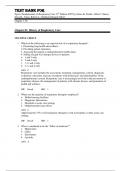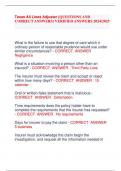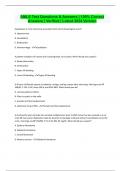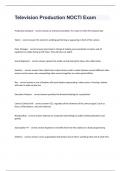Test Bank For
Egan's Fundamentals of Respiratory Care 13th Edition 2025 by James K. Stoller, Albert J. Heuer,
David L. Vines, Robert L. Chatburn Eduardo Mirel
Chapter 1-58
Chapter 01: History of Respiratory Care
MULTIPLE CHOICE
1. Which of the following is an expected role of a respiratory therapist?
1. Promoting lung health and wellness
2. Providing patient education
3. Assessing the patient’s cardiopulmonary health status
4. Selling oxygen (O2) therapy devices to patients
a. 1 and 3 only
b. 2 and 4 only
c. 1, 2, and 3 only
d. 2, 3, and 4 only
ANS: C
Respiratory care includes the assessment, treatment, management, control, diagnostic
evaluation, education, and care of patients with deficiencies and abnormalities of the
cardiopulmonary system. Respiratory care is increasingly involved in the prevention of
respiratory disease, the management of patients with chronic disease, and promotion of
health and wellness.
DIF: Recall OBJ: 1
2. Where are the majority of respiratory therapists employed?
a. Skilled nursing facilities
b. Diagnostic laboratories
c. Hospitals or acute care settings
d. Outpatient physician offices
ANS: C
Approximately 75% of all respiratory therapists work in hospitals or other acute care
settings.
DIF: Recall OBJ: 1
3. Who is considered to be the ―father of medicine‖?
a. Hippocrates
b. Galen
c. Erasistratus
d. Aristotle
ANS: A
, The foundation of modern Western medicine was laid in ancient Greece with the
development of the Hippocratic Corpus. This collection of ancient medical writings is
attributed to the ―father of medicine,‖ Hippocrates, a Greek physician who lived during the
fifth and fourth centuries BC.
DIF: Recall OBJ: 2
4. In 1662, a chemist published a book that described the relationship between gas, volume,
and pressure. What was the chemist’s name?
a. Sir Isaac Newton
b. Robert Boyle
c. Anthony van Leeuwenhoek
d. Nicolaus Copernicus
ANS: B
The chemist, Robert Boyle, published what is now known as ―Boyle’s law,‖ governing the
relationship between gas, volume, and pressure.
DIF: Recall OBJ: 2
5. Who discovered O2 in 1774 and described it as ―dephlogisticated air‖?
a. Robert Boyle
b. Jacque Charles
c. Thomas Beddoes
d. Joseph Priestley
ANS: D
In 1774, Joseph Priestley described his discovery of O2, which he called ―dephlogisticated
air.‖
DIF: Recall OBJ: 2
6. Who is credited with first describing the law of partial pressures for a gas mixture?
a. John Dalton
b. Joseph Prestley
c. Jacque Charles
d. Thomas Young
ANS: A
John Dalton described his law of partial pressures for a gas mixture in 1801 and his atomic
theory in 1808.
DIF: Recall OBJ: 2
7. Who was the first scientist in 1865 to suggest that microorganisms caused many diseases?
a. Thomas Young
b. Louis Pasteur
c. Henry Graham
d. Robert Koch
ANS: B
, In 1865, Louis Pasteur advanced his ―germ theory‖ of disease, which held that many
diseases are caused by microorganisms.
DIF: Recall OBJ: 2
8. Who discovered the x-ray and opened the door for the modern field of radiology?
a. John Dalton
b. William Smith
c. William Roentgen
d. Thomas Young
ANS: C
In 1895, William Roentgen discovered the x-ray and the modern field of radiologic
imaging sciences was born.
DIF: Recall OBJ: 2
9. What was the primary duty of the first inhalation therapists?
a. Provide airway care.
b. Support O2 therapy.
c. Aerosol therapy to patients.
d. Maintain patients on mechanical ventilation.
ANS: B
The first inhalation therapists were really just O2 technicians.
DIF: Recall OBJ: 3
10. When did the designation ―respiratory therapist‖ become standard?
a. 1954
b. 1964
c. 1974
d. 1984
ANS: C
In 1974, the designation ―respiratory therapist‖ became standard.
DIF: Recall OBJ: 3
11. Who was the first to develop the large-scale production of O2 in 1907?
a. Robert Dalton
b. David Boyle
c. Thomas Anderson
d. Karl von Linde
ANS: D
Large-scale production of O2 was developed by Karl von Linde in 1907.
DIF: Recall OBJ: 4
12. When was the first Venti-mask introduced that allows the precise delivery of 24%, 28%,
35%, and 40% O2?
, a. 1945
b. 1954
c. 1960
d. 1972
ANS: C
The Campbell Venti-mask, which allowed the administration of 24%, 28%, 35%, or 40%
O2, was introduced in 1960.
DIF: Recall OBJ: 4
13. When were aerosolized glucocorticoids for the maintenance of patients with moderate to
severe asthma first introduced?
a. In the 1950s
b. In the 1960s
c. In the 1970s
d. In the 1980s
ANS: C
The use of aerosolized glucocorticoids for the maintenance of patients with moderate to
severe asthma began in the 1970s.
DIF: Recall OBJ: 4
14. Which of the following medications has never been delivered as an aerosol by a
respiratory therapist?
a. Inotropes
b. Anticholinergic
c. Mucolytic
d. Antibiotic
ANS: A
There has been a proliferation of medications designed for aerosol administration,
including bronchodilators, mucolytic, antibiotic, anticholinergic, and antiinflammatory
agents.
DIF: Recall OBJ: 4
15. Which two names are linked to the development of the iron lung, which was extensively
used to treat the polio epidemic in the 1950s?
a. Allison and Smyth
b. Drinker and Emerson
c. Drager and Bennett
d. Byrd and Tyler
ANS: B
The iron lung was developed by Drinker, an engineer at Harvard University. Jack H.
Emerson developed a commercial version of the iron lung that was used extensively
during the polio epidemics of the 1930s and 1950s.
DIF: Recall OBJ: 5







